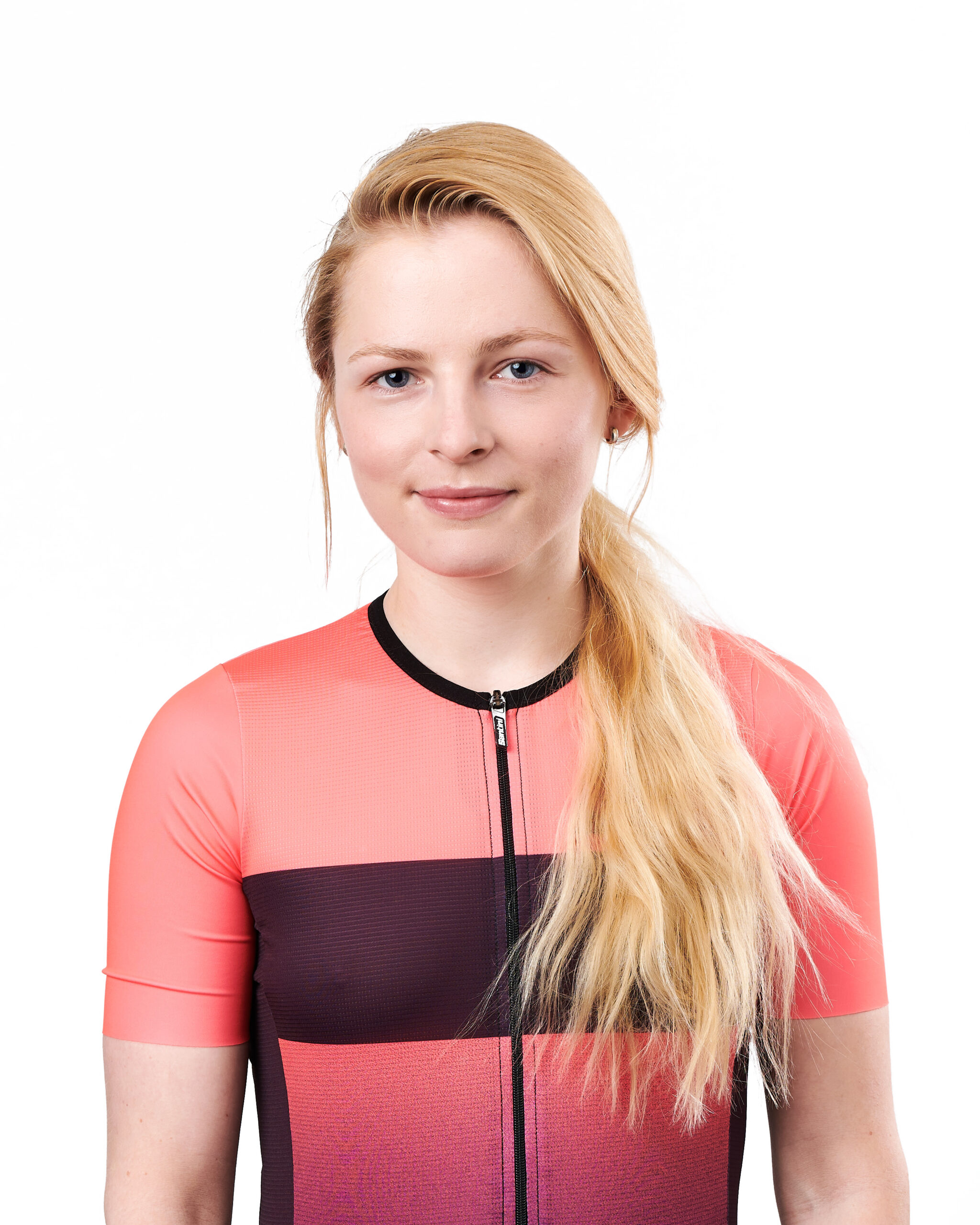If you're keen to keep swimming through winter but haven't done so before, there are a few things you'll need to get – namely, cold water swimming gear. Here, we've rounded up some of the best best cold water swimming gloves.
Once you're sorted with some gloves, you'll also want to invest in some cold water swim hats, cold water swimming socks and a changing robe for when you're out of the water.
Best cold water swimming gloves for winter
Zone3 Neoprene Heat-Tech Swimming Gloves
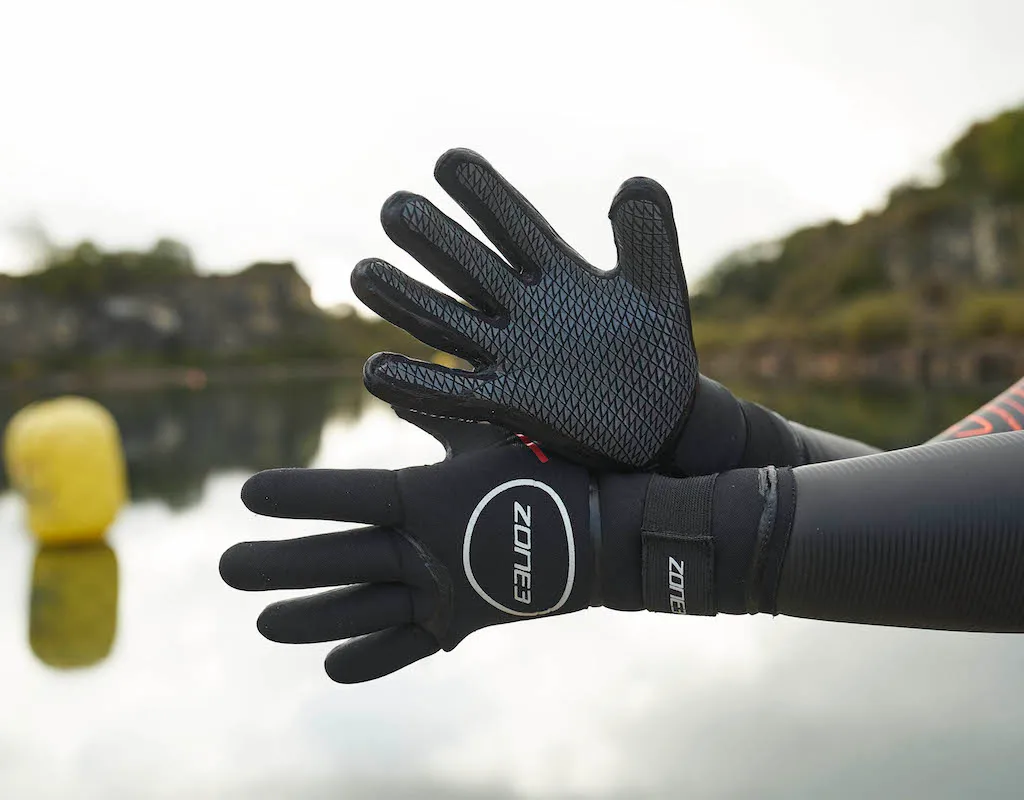
- £39 / $59
Zone3 aren’t messing around with their Heat-Tech range, and in last year’s test we said these gloves were our new gold standard for cold swims.
The 3.5mm neoprene with titanium lining makes them very warm and, with a liquid seal finish, I got a really snug yet flexible fit with no water ingress.
In fact, your hands emerge from your swim dry, which is an odd feeling!
The long cuffs make them easy to tuck into your wetsuit sleeves, but, uniquely, those extra Velcro straps give an extra layer of security and make them ideal for non-wetsuit swimmers as no water can flow in.
My only note is that, like the brand's swimming socks, they’re very tricky to get off, so if you aren’t comfortable asking for help or have any issues with mobility in your hands, these may not be for you.
Pricing is good, but pipped by Lomo.
Verdict: The warmest on test and superb construction and fit.
Score: 90%
HUUB Neoprene Swim Gloves
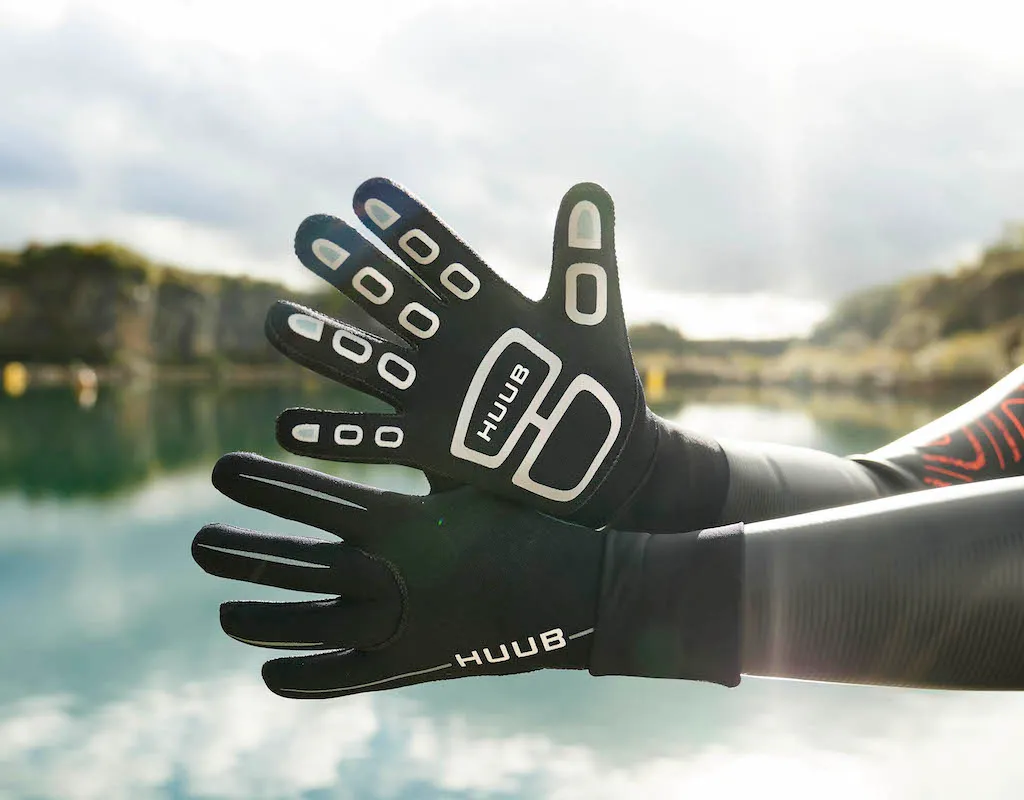
- £34.99
Coming in three sizes, S, M and L, these gloves share many design features with the brand's swim socks.
They’re made from 3mm neoprene and have silver graphics, which also act as a grippy surface – handy for holding on when getting in and out of cold water (you definitely don’t want to slip and fall in suddenly!).
I've used these gloves several times in the past and like the long but soft wrist, which makes them easy to tuck into the cuffs of your wetsuit.
They're also also one of the easiest pairs of gloves to pull off again after your swim.
While that’s a real plus it does come at the cost of preventing water ingress though, as the size small was still a little big for this female tester and on longer swims I had a bit of water ingress.
But it’s not a deal-breaker on a very easy-to-use pair of gloves.
Verdict: Very easy to use and very comfy; easy to tuck under your wetsuit, but not as waterproof as others.
Score: 84%
2XU Propel Neoprene Gloves
Buy it from 2XU (£45)
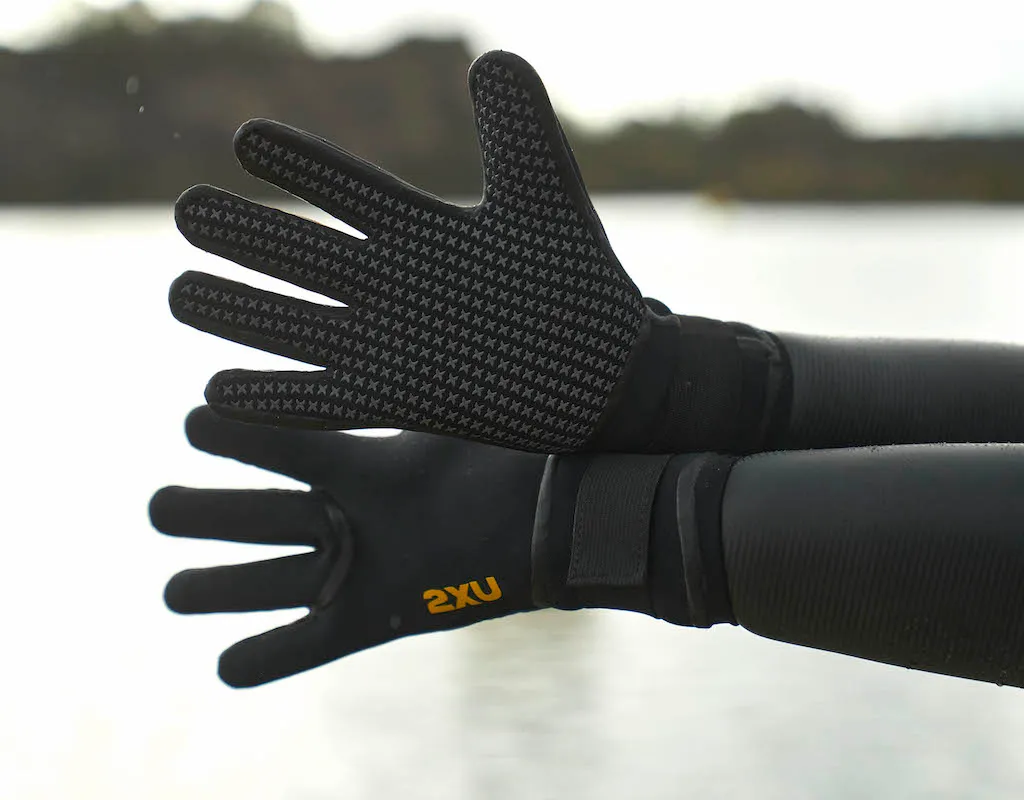
- £45 / $59.99
These are well-considered gloves, with several features that drew me to them straight away.
First up, there’s that wrist band and longer length, which means you can achieve a more snug fit.
This prevents water seeping in and also helps keep the gloves in place, but without having to size down to a point where the gloves are difficult to get on and off.
If gloves are too big they will ‘balloon’ and be chilly and at risk of falling off. That said, three sizes are available (S, M and L) and the size small felt a good fit on this female tester.
My only caveat being it did take a while to tuck them under the cuffs of my wetsuit!
Like the cap, the neoprene is 3mm and here a grippy ‘x’ design on the palms helps feel for water as you swim, but in my book was also very handy for grabbing on to cold, slippy rails post-swim.
Verdict: Very snug gloves if a size works for you and superb grip, but not cheap and tricky to get off.
Score: 88%
Lomo Swimming and Triathlon Gloves
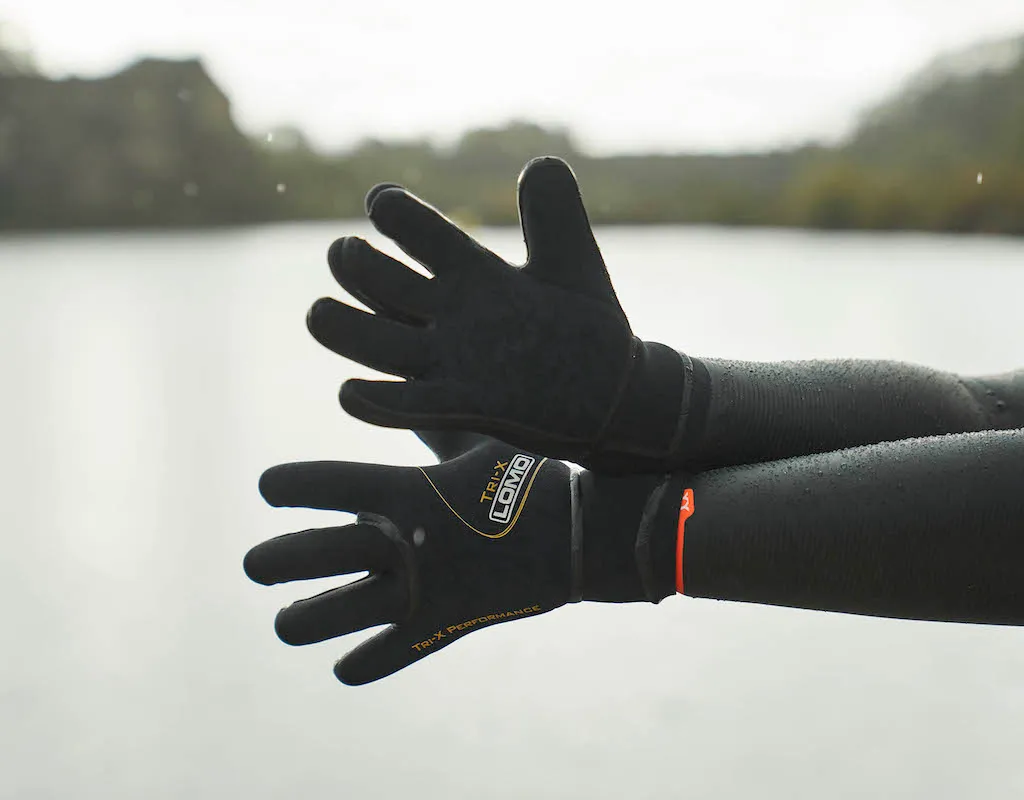
- £21 (UK only)
What you can’t see from our photos here is that these gloves from top budget swim brand Lomo come in two other colourways – bright pink and bright orange.
While that might not make them the first choice for many triathletes, we love a bit of colour for increased visibility in open water, it all helps to keep you safe.
Still, for those wanting a traditional black these come in at the same price.
They're well worth that price, too, with seamed seals and a gasket at the wrist meaning no water can get inside, while stretchy 3mm neoprene is as warm as any of the others on test but without the price tag.
Sizing is good too, with these coming in XS through to XL. My test pair were maybe a little large but I could have sized down and they still did a great job of keeping water out.
Verdict: You can't argue with that price – less than half the RRP of others and plenty of features.
Score: 85%
Orca Thermal Gloves
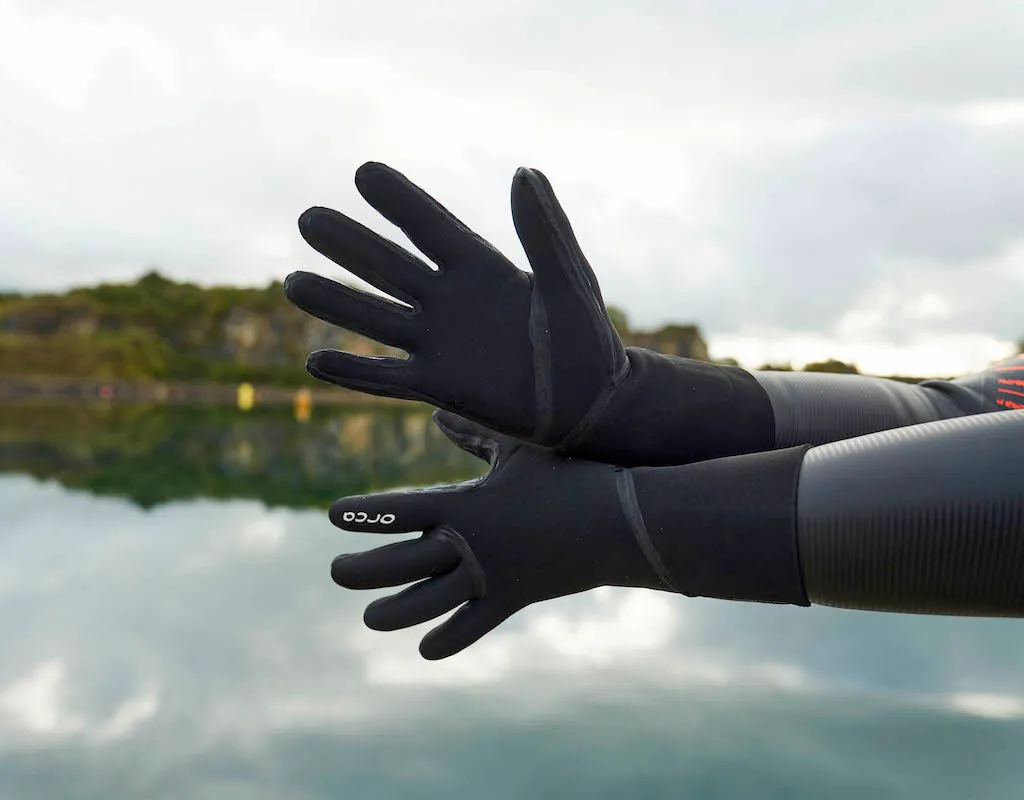
- £47 / $65
Like the unisex booties, these Orca gloves come in a wide range of sizes – the women’s in XS, S and M and the men’s in S, M and L.
Why is this good? Well, the better the fit, the less cold your hands will get as water won’t be seeping in.
Plus, you will also find that a nice close fit means you have better control of the water and aren’t slapping it with baggy gloves.
This tester, used to not being able to find swim gloves small enough, initially went for an XS, which was too small, but the S was perfect.
The welded seams kept water out, the 3mm neoprene with thermal lining was very warm and these gloves retained their shape well, even when wet.
I also liked the wide, fluted opening, which kept my wrists warm and tucked inside my wetsuit nicely, yet were very easy to remove post-swim.
Verdict: Soft, comfortable gloves that hold their shape well and fit nicely under a wetsuit.
Score: 86%
Dhb Hydron Thermal Swim Gloves 2.0
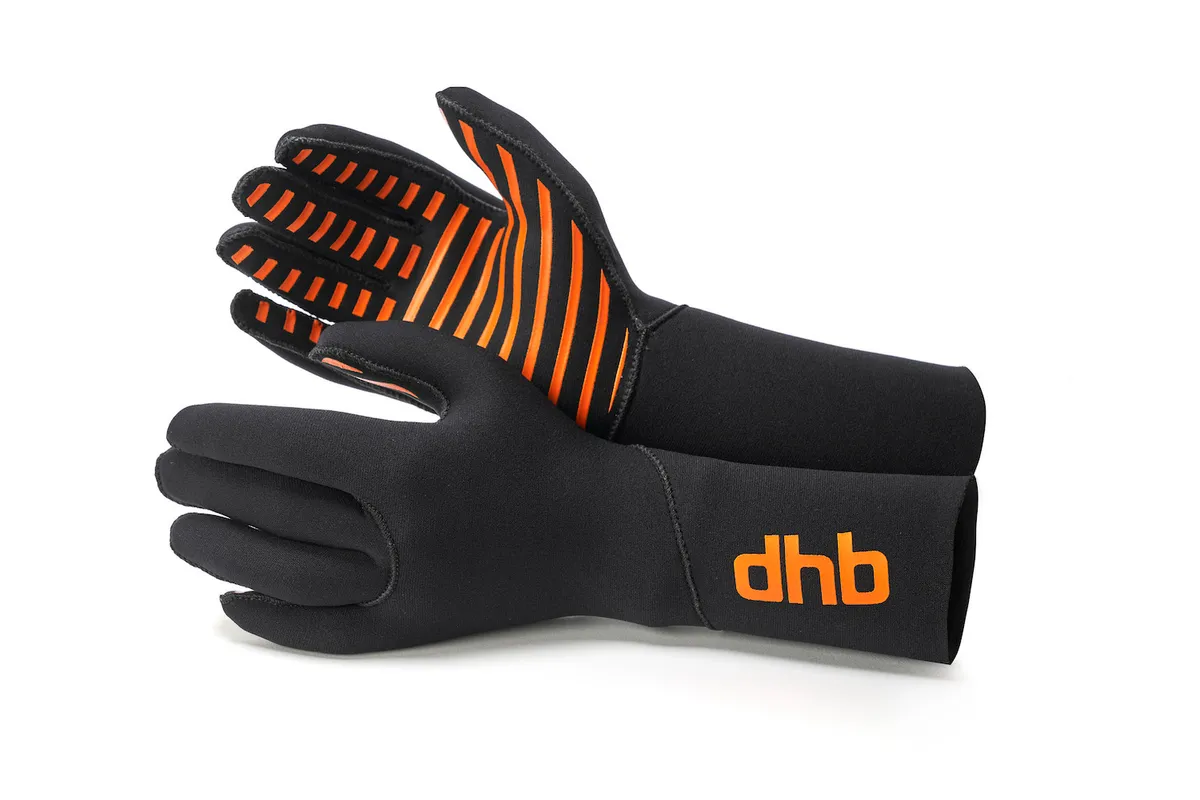
- £30 (UK only)
Coming in at a fiver more than the regular Dhb swim gloves, these use the same soft thermal lining as the brand's superb Aeron Thermal wetsuit.
This makes them comfortable, but, crucially when hands are cold, easier to remove when wet – and that’s helped by the extended tab on the cuffs.
The long, fitted cuffs are one of my favourite things about these gloves, too, meaning they’re easy to tuck under my wetsuit sleeves.
I found the fingers didn’t fit as well as some others on test due to the stitched edges, but the zingy orange, grippy print is a nice touch for visibility.
Verdict: Warm and quality gloves with extra features.
Score: 80%
Also consider...
Zone3 Neoprene Swimming Gloves
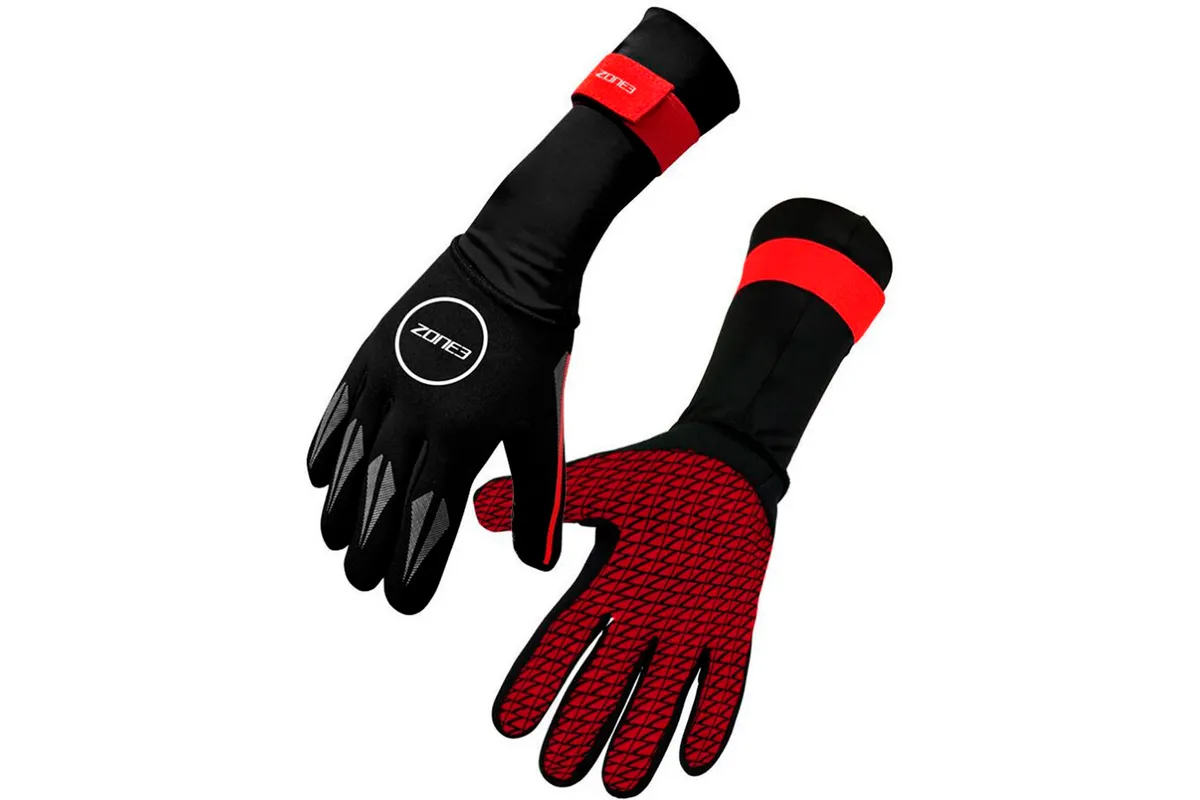
These gloves look the business with their dual red and black colourway and score of practical cold-water swimming specific features.
Made from stretchy 2mm neoprene with a composition of 90% neoprene, 10% nylon, these gloves should be super snug and flexible when on, allowing ample freedom of movement.
They feature a slightly longer length than others mentioned, which aims to fit snugly over or under your wetsuit with the help of an adjustable Velcro strap, and avoid water ingress.
The grippy, non-slip material on the palms should aid stability when manoeuvring into the water.
TWF Neoprene Gloves
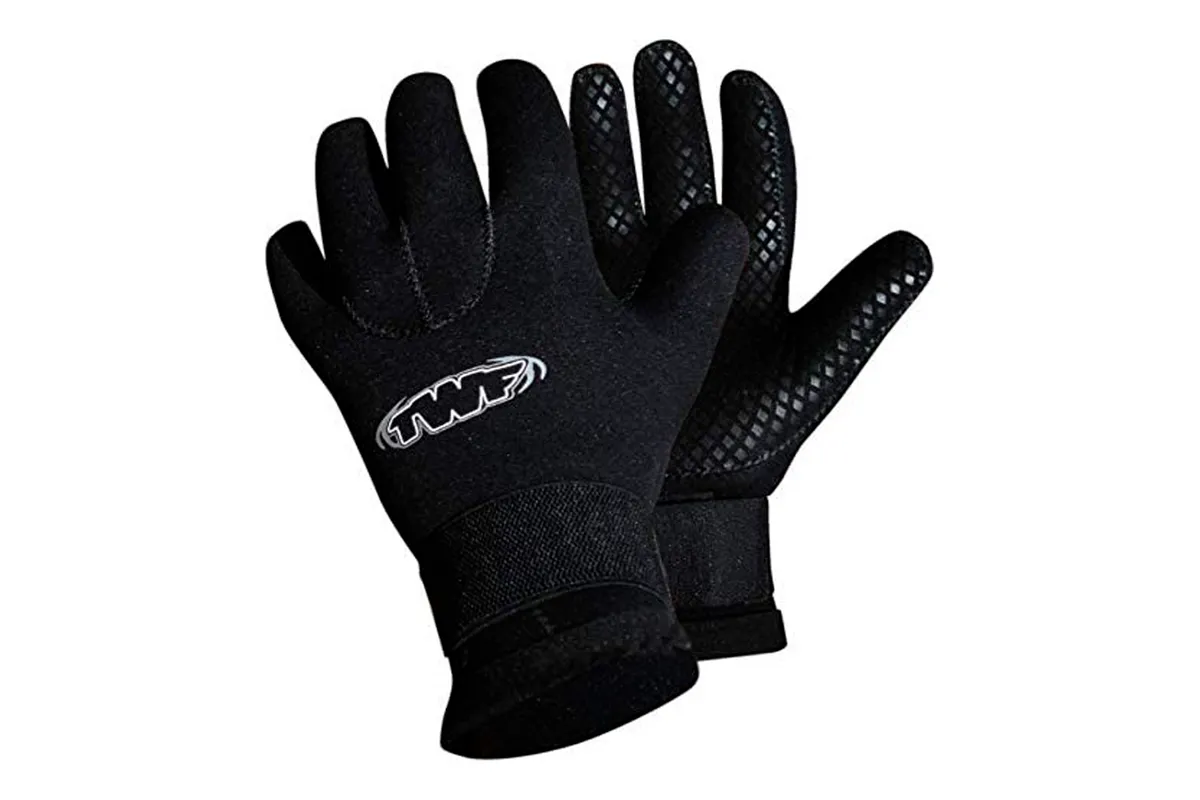
These TWF gloves can be found on Amazon and are made from 3mm neoprene, which should be fine for cold water swimming from spring to autumn-time. For added durability, TWF claim that the gloves are blindstiched and glued, which should also reduce water ingress.
The soles of the palms are designed with a textured print to aid grip and safety. You can also buy these as a bundle with matching neoprene TWF swim socks.
Slyzone Neoprene Wetsuit Gloves
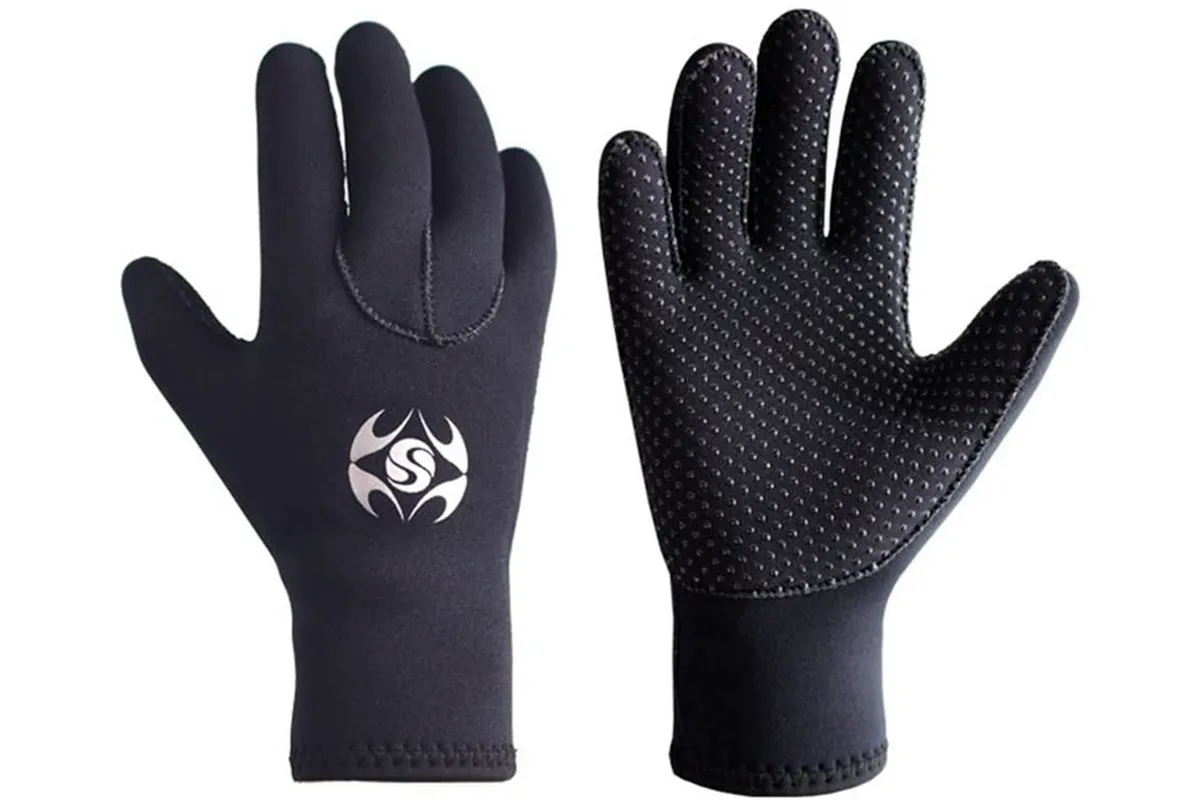
Amazon have 3mm Neoprene Wetsuit gloves from Slyzone, priced £13.99. 220's Kate has tested these with some wild river swimming and was suitably impressed. The 3mm thickness kept our fingers toasty and the grippy soles helped us scramble across slippy rocks getting into the water. A win in terms of price and usability, and after five months of use they are have shown no wear or tear.
Mares Flexa Classic Gloves
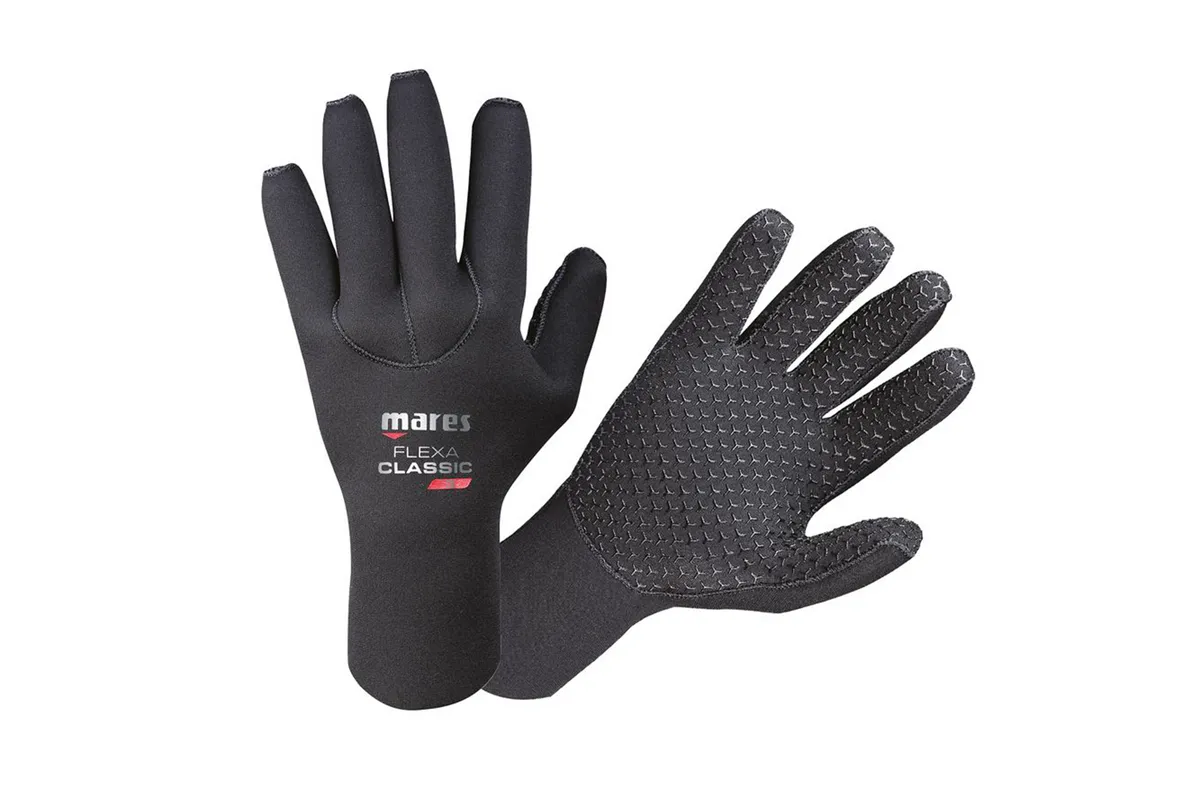
Made from double-lined neoprene, these dive gloves claim to be 'reliable and durable'. With a palm designed to stop any accidents when clambering out of the water thanks to the rubber print, these gloves should keep you safe and warm in all waters.
- How to manage Raynaud’s Syndrome when open-water swimming
- How to manage Raynaud’s Syndrome when running
- What to wear open water swimming: your essential kit guide to wild swimming
Decathlon Olaian Neoprene Gloves
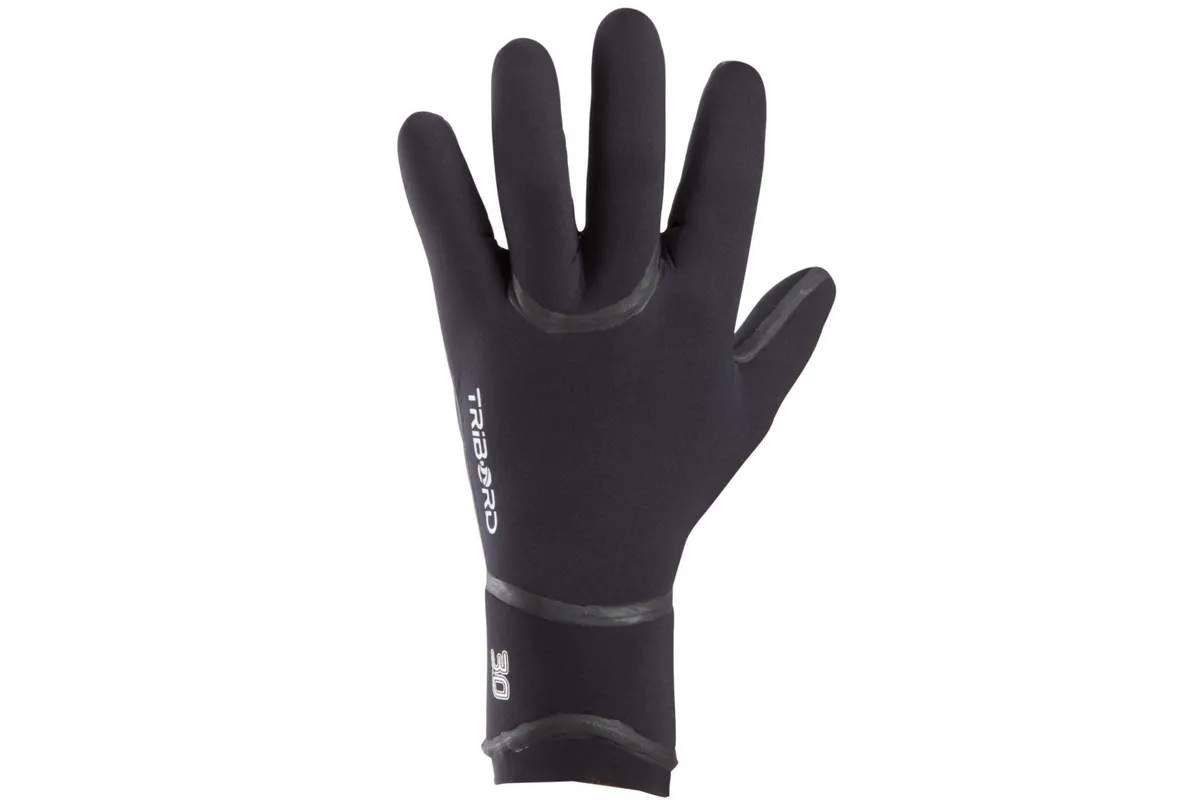
Unlike other gloves mentioned here, these 3mm surf gloves are made from 100% neoprene from elastomer foam, which should help keep your hands remain warm in the water, 'for sessions up to two hours' say Decathlon.
On top of this, the gloves are lined with synthetic fabric and are both blind-stitched and glued, which aims to make them more durable and prevent unwanted water ingress.
Blueseventy Thermal Swim Gloves
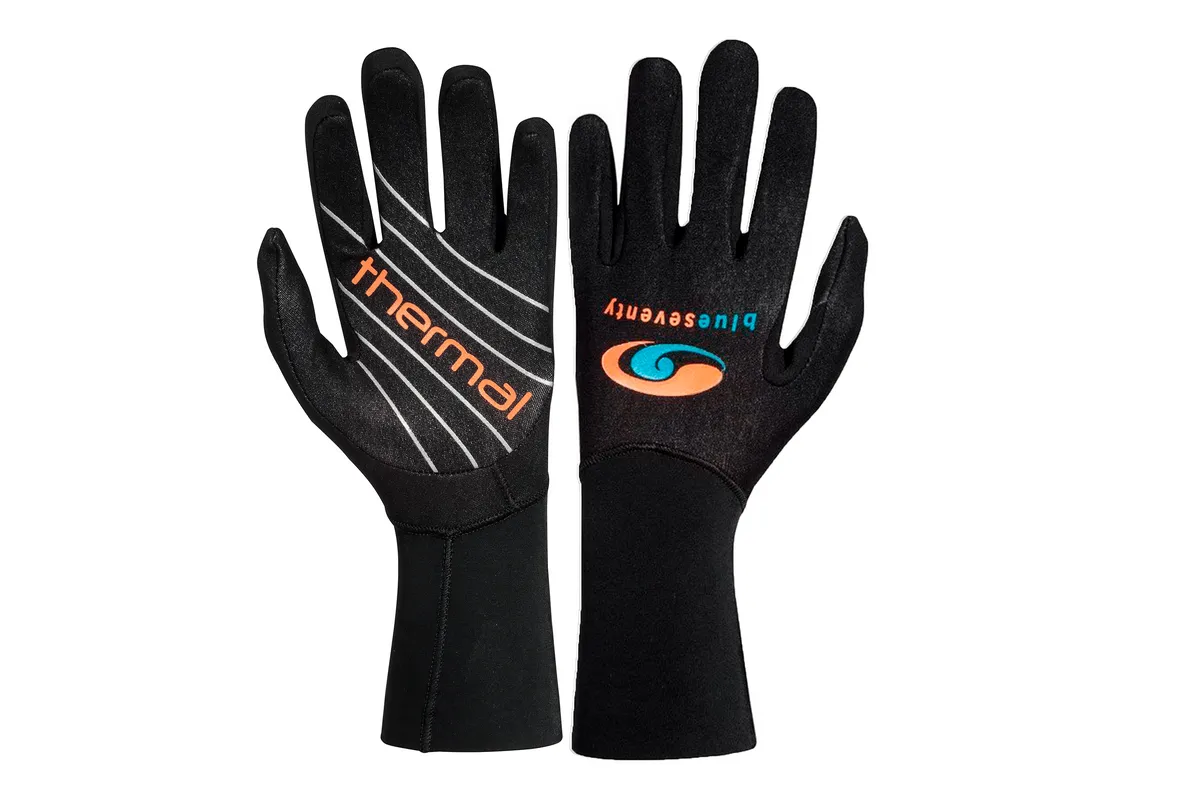
These open-water specific gloves have a keen thermal focus thanks to a ‘metal cell liner’ which should work to reduce heat loss through the fingers and maximise warmth.
Thanks to their longer sleeve length, water ingress should be minimal.
The wrist cuff design should also mean easy removal and Blueseventy claim that these gloves are also a great tool for keeping fingers ‘dry in foul bike riding weather.’
How we tested
Many of these cold-water swimming gloves have been tested across multiple winter seasons.
Any newer products have been worn for multiple swims in temperatures down to 5°C, with swim distances ranging from 1,000m to 3,000m, depending on water temperatures at the time.
The testing has been carried out by 220 Triathlon editor (and open-water swim coach) Helen Webster, who's been reviewing swimming gear for over 10 years.
She tested these products based on the criteria listed below.
What to look for in swimming gloves?
In terms of warmth, the thicker the better is generally the rule. However, this can be at the expense of mobility and fit.
A general standard in gloves for cold water swimming seems to hover around the 3mm thickness of neoprene, but we'd go .5mm either side.
Much thicker than 4mm and you'll lose dexterity in the water, which is crucial if you actually intend to swim rather than paddle in the gloves.
What can help is a strap at the top of the glove to help seal the cuff and prevent too much cold water entering into them, though this feature may add a few ££s to the price.
Look for gloves with good, 'welded' seams too, which will add waterproofing. Finally, ensure you get a good, close fit.
Gloves will give a little in the water usually and if you end up with water sloshing around inside them not only will that feel cold, but it will also make swimming feel cumbersome.
Why do neoprene gloves help when cold water swimming?
When we put our body into cold water (defined in the UK as water below 15°C), our body protects our core by sending blood from our limbs to the centre of our body.
This means our arms and legs are effectively 'amputated' and will have less warmth circulating within them.
Our fingers especially feel the cold as they have a large surface area to mass, which means they are very exposed to the cold water and chill quickly.
Add to that the fact that they are moving in and out of the water (if doing front crawl) and therefore being exposed to wind chill, and you start to see how gloves can be very welcome!
Even swimmers who don't wear wetsuits year round will often add a pair of swim gloves and boots to protect the sensitive extremities and keep the swim more comfortable.
How to warm up safely after cold-water swimming
In search of more triathlon kit to improve your swim? See our round-up of the best swim hand paddles for triathlon training.

